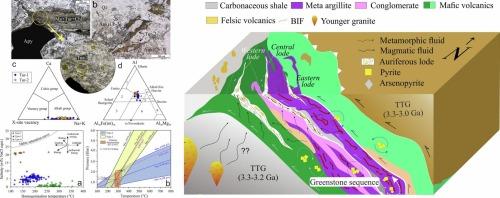印度达瓦尔克拉通Gadag金矿流体包裹体、稳定同位素及电气石化学:含金流体变质成因的启示
IF 3.6
2区 地球科学
Q1 GEOLOGY
引用次数: 0
摘要
造山带金矿床中含金流体和金属的来源一直是争论不休的问题。本文以印度Dharwar克拉通西部的Gadag金矿为研究对象,研究了具有代表性的绿岩型造山带金系统的形成过程。金矿床的岩性组合(变质玄武岩、变质泥质岩和BIF)和空间分布需要进行矿床专题研究,而其他造山带金矿床则集中在达瓦尔克拉通东部。GGF含金矿石流体的性质和来源仍有争议,需要进一步限制。GGF包括3个含金矿脉(西部、中部和东部),分别赋存于变质玄武岩、泥质岩和带状铁地层(BIF)中。尽管寄主岩石岩性不同,但西部和中部矿脉的蚀变组合相似(石英+碳酸盐+白云母+绿泥石+绢云母±电气石+毒砂+黄铁矿+黄铜矿±闪锌矿)。岩石学和显微构造特征表明,该成矿阶段对应于渐进性D3右旋剪切作用。在渐进变形过程中,阶段1之后是阶段2。虽然可见的天然金颗粒很少,但毒砂的电子探针分析显示,GGF中存在结构结合的不可见难熔金。对石英-碳酸盐岩脉的详细流体包裹体(FI)研究表明,这是一种低至中盐(0.04-9.6 wt% NaCl当量)、还原的H2O-NaCl-CO2±CH4流体,具有流体不混溶性的证据。流体包裹体和绿泥石测温估算的成矿条件(1.2 ~ 2.0 kbar, 275 ~ 333℃)与绿片岩相蚀变相一致。矿化带电气石地球化学特征(Naavg ~ 0.68 apfu,低Fe3+/Fe2+, Fe- mg比值)和同值硫化物反映了矿化带低盐化、流体还原的特征,并推断了富铁元玄武岩在流-岩相互作用过程中铁向绿泥石和硫化物的分配。矿化硫化物颗粒(+1.5 ~ +4.5‰)与寄主岩石黄铁矿(-1 ~ +3.8‰)的δ34S同位素数据相似且重叠,表明寄主岩石的岩浆和变质沉积黄铁矿在高流体通量时期溶蚀作用贡献了热液系统中的大部分硫。而碳同位素值(δ13Cfluid:−6.0 ~ +1.5‰)表明,碳来源于缓冲良好、同位素均质的流体储层,很可能是由研究区含碳酸盐岩性和/或深层变质流体体系相互作用维持的。这些同位素特征,结合电气石和FI数据,主要支持GGF含金流体的变质成因,但也不能完全排除岩浆流体的影响。在剪切带活化过程中,金可能以Au(HS)2−的形式运移,并因压降引起的相分离和围岩相互作用而析出。本文章由计算机程序翻译,如有差异,请以英文原文为准。

Fluid inclusion, stable isotope and tourmaline chemistry at Gadag Gold Field, Dharwar Craton, India: Implications for metamorphic origin of auriferous fluid
The sources of auriferous fluid and metal in orogenic gold deposits have long been a subject of debate. This paper investigates the Gadag Gold Field (GGF) in the western Dharwar Craton, India—a representative greenstone-hosted orogenic gold system—to understand the gold forming process. The litho associations (metabasalt, meta-argillite and BIF) and spatial distribution of GGF demands a deposit specific study, while other orogenic gold deposits are in the eastern Dharwar Craton. The nature and sources of the auriferous ore fluid in GGF are still arguable and require further constraints. The GGF comprises three auriferous lodes (western, central, and eastern), hosted in metabasalt, argillite, and banded iron formation (BIF), respectively. Despite lithological differences in host rock, the western and central lodes show similar alteration assemblages (quartz + carbonate + muscovite + chlorite + sericite ± tourmaline + arsenopyrite + pyrite + chalcopyrite ± sphalerite).
Petrography and microstructures indicate two stages of mineralization corresponds to progressive D3 dextral shearing. Where stage-1 is followed by stage-2 during progressive deformation. Although visible native gold grains are rare, electron microprobe analysis of arsenopyrite reveals the presence of structure-bound invisible refractory gold in the GGF. Detailed fluid inclusion (FI) studies on quartz-carbonate veins reveal a low- to medium-saline (0.04–9.6 wt% NaCl equiv.), reduced H2O-NaCl-CO2 ± CH4 fluid, with evidence for fluid immiscibility. Estimated mineralization conditions (1.2–2.0 kbar, 275–333 °C) from fluid inclusion and chlorite thermometry is consistent with greenschist-facies alteration. Tourmaline geochemistry (Naavg ∼ 0.68 apfu, low Fe3+/Fe2+, Fe-Mg ratio) and coeval sulfides from the mineralized zone reflect the characteristics of low saline, reduced fluid and partitioning of Fe into chlorite and sulfides during fluid-rock interaction with Fe-rich metabasalt is also inferred.
The similar and overlapping ranges of δ34S isotopic data between mineralized sulfide grains (+1.5 to +4.5 ‰) and host rock pyrites (–1 to +3.8 ‰), suggest the dissolution of preexisting magmatic and metasedimentary pyrites of the host rocks during high fluid flux contributed most of the sulfur in the hydrothermal system. While carbon isotope values (δ13Cfluid: −6.0 to +1.5 ‰) indicate that the carbon was sourced from a well-buffered and isotopically homogeneous fluid reservoir, most likely maintained by interaction with carbonate-bearing lithologies present in the study area and/or a deep-seated metamorphic fluid system. These isotopic signatures, combined with tourmaline and FI data, predominantly support metamorphogenic origin of the auriferous fluid at GGF, though influences of magmatic fluid could not be completely ruled out. Where gold was likely transported as Au(HS)2− and precipitated due to pressure drop-induced phase separation and wall-rock interaction during shear zone reactivation.
求助全文
通过发布文献求助,成功后即可免费获取论文全文。
去求助
来源期刊

Ore Geology Reviews
地学-地质学
CiteScore
6.50
自引率
27.30%
发文量
546
审稿时长
22.9 weeks
期刊介绍:
Ore Geology Reviews aims to familiarize all earth scientists with recent advances in a number of interconnected disciplines related to the study of, and search for, ore deposits. The reviews range from brief to longer contributions, but the journal preferentially publishes manuscripts that fill the niche between the commonly shorter journal articles and the comprehensive book coverages, and thus has a special appeal to many authors and readers.
 求助内容:
求助内容: 应助结果提醒方式:
应助结果提醒方式:


